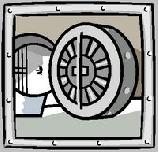
 |
|
| Financial Terms | |
| Chattel |
|
Information about financial, finance, business, accounting, payroll, inventory, investment, money, inventory control, stock trading, financial advisor, tax advisor, credit.
Main Page: credit, investment, money, financial, payroll, stock trading, business, financial advisor, |
Definition of Chattel
ChattelPersonal property other than interests in land.
Related Terms:Best-interests-of-creditors testThe requirement that a claim holder voting against a plan of reorganization Common stock/other equityValue of outstanding common shares at par, plus accumulated retained Other capitalIn the balance of payments, other capital is a residual category that groups all the capital Other current assetsValue of non-cash assets, including prepaid expenses and accounts receivable, due Other long term liabilitiesValue of leases, future employee benefits, deferred taxes and other obligations Other sourcesAmount of funds generated during the period from operations by sources other than Personal tax view (of capital structure)The argument that the difference in Personal tax rates between  Personal trustAn interest in an asset held by a trustee for the benefit of another person. Pooling of interestsAn accounting method for reporting acquisitions accomplished through the use of equity. Property rightsRights of individuals and companies to own and utilize property as they see fit and to receive Separation propertyThe property that portfolio choice can be separated into two independent tasks: 1) PROPERTY AND EQUIPMENTAssets such as land, buildings, machinery, and equipment that the business will use for several LandThe cost of land owned by the company. Land improvementsThe cost of improvements to land owned by the company, such as fencing and outdoor lighting. property, plant, and equipmentThis label is generally used in financial Other assetsA cluster of accounts that are listed after fixed assets on the balance sheet,  Pooling of interestsAn method for accounting for a business combination. When used, the expenses of the combination are charged against income at once, and the net Property, plant, and equipmentThis item is comprised of all types of fixed assets Personal Responsibility and Work Opportunity Reconciliation ActA federal Act requiring the reporting of new hires into a national database. Accumulated Other Comprehensive IncomeCumulative gains or losses reported in shareholders' Other-than-Temporary Decline in Market ValueThe standard used to describe a decline in market value that is not expected to recover. The use of the other-than-temporary description as Personal AssetsAssets, the title of which are held Personally rather than in the name of some other legal entity. Personal GuaranteeA legal document whereby an individual takes responsibility for payment of debt or performance of some obligation if the person/company primarily liable fails to perform. Personal Overdraft FacilityA loan facility on a customers account at a financial institution allowing the customer to overdraw up to a certain agreed limit for an agreed period. personal loanA lump sum that you borrow from a financial institution for a specified period of time. To repay the loan, you pay interest on the entire lump sum, and make payments on a scheduled basis. PIN (personal identification number)A secret code that you use to access your bank account at a bank machine or at a point of sale (POS) terminal. You may also have a PIN for banking by telephone. personal line of credit (PLC)A revolving source of credit with a pre-established limit. You access the funds only as you need them, and any amount that you pay back becomes accessible to you again. Unlike a Personal loan, a PLC permits you to write cheques and make bank machine withdrawals, and requires you to pay interest only on the funds that you actually use.  Personal Line of credit (Credit Insurance)A bank's commitment to make loans to a borrower up to a specified maximum during a specific period, usually one year. Related to : financial, finance, business, accounting, payroll, inventory, investment, money, inventory control, stock trading, financial advisor, tax advisor, credit. |